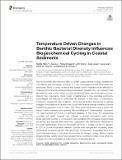Files in this item
Temperature driven changes in benthic bacterial diversity influences biogeochemical cycling in coastal sediments
Item metadata
| dc.contributor.author | Hicks, Natalie | |
| dc.contributor.author | Liu, Xuan | |
| dc.contributor.author | Gregory, Richard | |
| dc.contributor.author | Kenny, John | |
| dc.contributor.author | Lucaci, Anita | |
| dc.contributor.author | Lenzi, Luca | |
| dc.contributor.author | Paterson, David M. | |
| dc.contributor.author | Duncan, Katherine R. | |
| dc.date.accessioned | 2018-08-23T10:30:36Z | |
| dc.date.available | 2018-08-23T10:30:36Z | |
| dc.date.issued | 2018-08-22 | |
| dc.identifier | 255534834 | |
| dc.identifier | f87dd84d-c103-432f-8ab8-f015e1de0360 | |
| dc.identifier | 85052641172 | |
| dc.identifier | 000442363000001 | |
| dc.identifier.citation | Hicks , N , Liu , X , Gregory , R , Kenny , J , Lucaci , A , Lenzi , L , Paterson , D M & Duncan , K R 2018 , ' Temperature driven changes in benthic bacterial diversity influences biogeochemical cycling in coastal sediments ' , Frontiers in Microbiology , vol. 9 , 1730 . https://doi.org/10.3389/fmicb.2018.01730 | en |
| dc.identifier.issn | 1664-302X | |
| dc.identifier.other | RIS: urn:0427233FC640A794F59DDE2E4DBCD777 | |
| dc.identifier.other | ORCID: /0000-0003-1174-6476/work/47725842 | |
| dc.identifier.uri | https://hdl.handle.net/10023/15858 | |
| dc.description | The authors would like to acknowledge funding from the Natural Environmental Research Council (NERC) grant NE/E006795/1 and the Pilot Competition grant number NBAF908 NBAF-L. PCR amplification, sequencing and taxonomic analysis was carried out at the NERC Biomolecular Analysis Facility (NBAF), Liverpool, UK. This work received funding from the MASTS pooling initiative (The Marine Alliance for Science and Technology for Scotland) and their support is gratefully acknowledged. MASTS is funded by the Scottish Funding Council (grant reference HR09011) and contributing institutions. | en |
| dc.description.abstract | Marine sediments are important sites for global biogeochemical cycling, mediated by macrofauna and microalgae. However, it is the microorganisms that drive these key processes. There is strong evidence that coastal benthic habitats will be affected by changing environmental variables (rising temperature, elevated CO2), and research has generally focused on the impact on macrofaunal biodiversity and ecosystem services. Despite their importance, there is less understanding of how microbial community assemblages will respond to environmental changes. In this study, a manipulative mesocosm experiment was employed, using next-generation sequencing to assess changes in microbial communities under future environmental change scenarios. Illumina sequencing generated over 11 million 16S rRNA gene sequences sequences (using a primer set biased towards bacteria) and revealed Bacteroidetes and Proteobacteria dominated the total bacterial community of sediment samples. In this study, the sequencing coverage and depth revealed clear changes in species abundance within some phyla. Bacterial community composition was correlated with simulated environmental conditions, and species level community composition was significantly influenced by the mean temperature of the environmental regime (p = 0.002), but not by variation in CO2 or diurnal temperature variation. Species level changes with increasing mean temperature corresponded with changes in NH4 concentration, suggesting there is no functional redundancy in microbial communities for nitrogen cycling. Marine coastal biogeochemical cycling under future environmental conditions is likely to be driven by changes in nutrient availability as a direct result of microbial activity. | |
| dc.format.extent | 15 | |
| dc.format.extent | 2881995 | |
| dc.language.iso | eng | |
| dc.relation.ispartof | Frontiers in Microbiology | en |
| dc.subject | Benthic biogeochemistry | en |
| dc.subject | Microbial communities | en |
| dc.subject | Biogeochemical cycles | en |
| dc.subject | Environmental change | en |
| dc.subject | Benthic microbial ecology | en |
| dc.subject | Marine sediments | en |
| dc.subject | QH301 Biology | en |
| dc.subject | NDAS | en |
| dc.subject | SDG 14 - Life Below Water | en |
| dc.subject.lcc | QH301 | en |
| dc.title | Temperature driven changes in benthic bacterial diversity influences biogeochemical cycling in coastal sediments | en |
| dc.type | Journal article | en |
| dc.contributor.sponsor | NERC | en |
| dc.contributor.sponsor | NERC | en |
| dc.contributor.institution | University of St Andrews. School of Biology | en |
| dc.contributor.institution | University of St Andrews. Sediment Ecology Research Group | en |
| dc.contributor.institution | University of St Andrews. Marine Alliance for Science & Technology Scotland | en |
| dc.contributor.institution | University of St Andrews. Scottish Oceans Institute | en |
| dc.contributor.institution | University of St Andrews. St Andrews Sustainability Institute | en |
| dc.identifier.doi | 10.3389/fmicb.2018.01730 | |
| dc.description.status | Peer reviewed | en |
| dc.identifier.grantnumber | NE/H017135/1 | en |
| dc.identifier.grantnumber | NE/N016009/1 | en |
This item appears in the following Collection(s)
Items in the St Andrews Research Repository are protected by copyright, with all rights reserved, unless otherwise indicated.

